Crafting a Tale of Ecology
In this lesson, students will view the Preston Singletary segment from the NATURE episode of the PBS series Craft in America. Students will hear from the artist, the team of assistants that help with his glasswork, and independent curator Miranda Belarde-Lewis, who is curating a show of Singletary’s work. The program features the Tlingit origin story Raven and the Box of Daylight as well as information about traditional Tlingit art, customs, and philosophy. After viewing the episode, students will discuss Singletary’s work and the Tlingit people’s connections to the natural world. Students will also examine the ecology of art materials. In the studio portion of the lesson, students will choose a traditional tale and rewrite it as an ecological fable. Students will share the tale by crafting a diorama that includes found materials.
SUPPORT MATERIALS
Crafting a Tale of Ecology
Full Guide & Worksheets
Background Reading
Lesson Overview
Teaching Tips
Teaching Tips for Teachers
Further Information
Resources & Materials for Teaching
Vocabulary
Vocabulary & Key Terms
Discussion Questions
Discussion Questions for Students
Worksheet #1 for Students
The Ecology of Art Materials
Worksheet #2 for Students
Crafting a Tale of Ecology
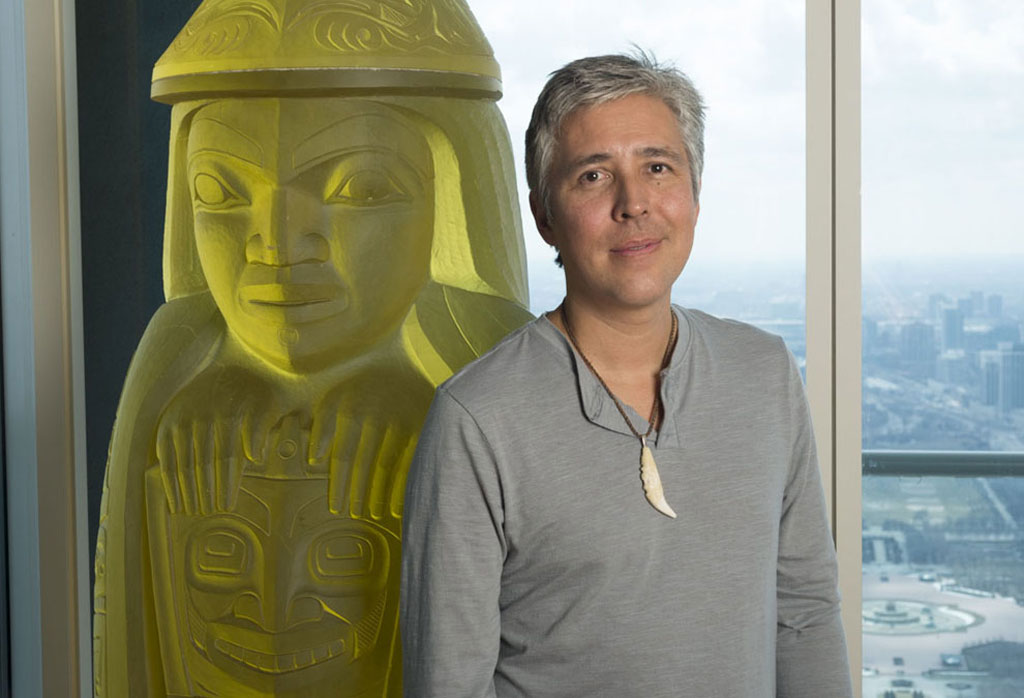
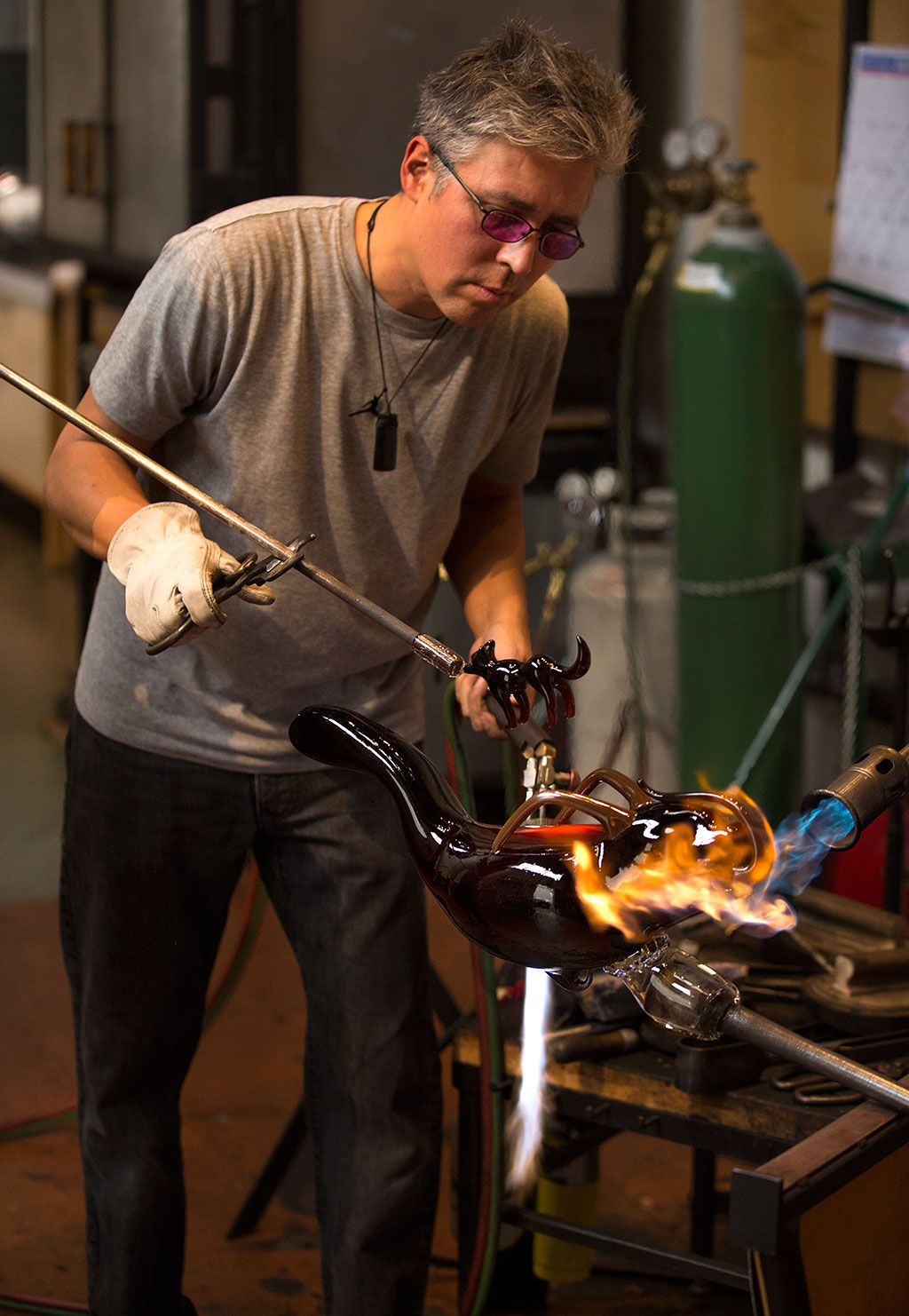
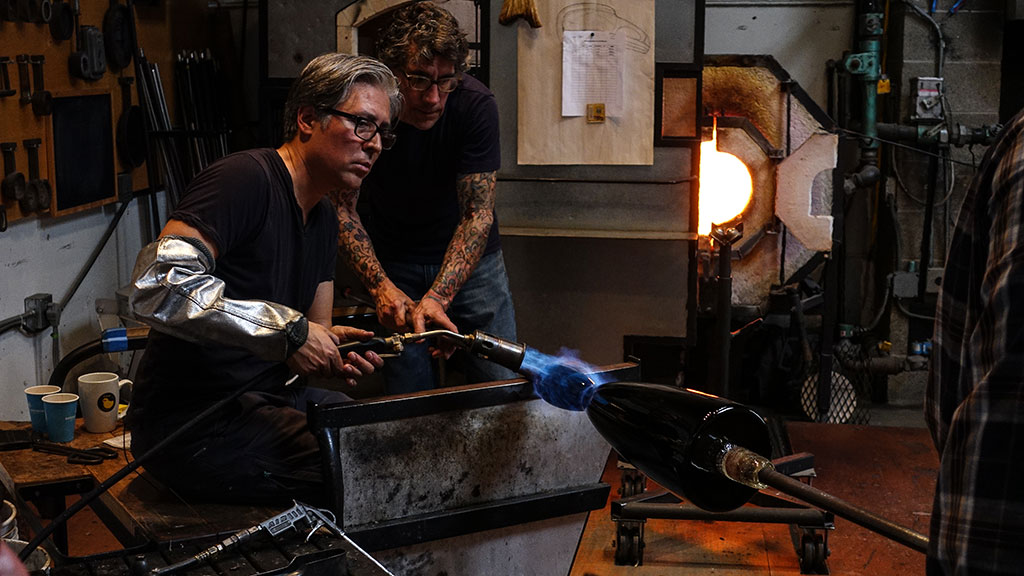
Native people are the best storytellers in the world because our stories carried knowledge. And that knowledge was needed to survive in a particular environment.
— Miranda Belarde-Lewis, Independent Curator
Grade Level: 9-12
Estimated Time: Two 45 minute class periods of discussion and research, Four 45 minute class periods of sketching and studio production
Background Information
Preston Singletary (b. 1963 in San Francisco, CA) is a Tlingit glass artist. He studied at the Pilchuck Glass School in Stanwood, Washington. Singletary transfers Tlingit designs, traditionally carved in wood, onto glass. Light is integral to his work, and he uses it to add dimension to the glass and his design. Singletary is surrounded by the wild natural beauty of the Pacific Northwest Coast. He captures the motion and magnificence of wild creatures in molten glass, then embellishes the cooled and hardened sculptures with symbols and designs from Tlingit culture. He is a pioneer, one of only a handful of Native American artists working in glass today. He explains as he works in his Seattle, WA studio, “When I began working with glass, I had no idea that I’d be so connected to the material in the way that I am. It was only when I began to experiment with using designs from the Tlingit cultural heritage that my work took on a new purpose and direction.” His work is in the collections of the Corning Museum of Glass, the Heard Museum, the Museum of Fine Arts, and Seattle Art Museum.
Key Concepts
- Connection to environment and place can be a theme for artist’s work.
- The art materials we choose have ecological significance.
- We understand our world through stories.
Critical Questions
- Why is connection to environment and place an important theme for some artist’s work?
- What is the ecological significance of the art materials we choose?
- How can telling stories enable (or limit) our understanding of the world?
Objectives
Students will:
- Understand that connection to environment and place can be a theme for an artist’s work.
- Research the sustainability and ecological significance of their chosen art materials.
- Develop an artwork that teaches the school community about an important family member or figure in the student’s life.
Vocabulary
Tlingit, Zuni, sustainable, stagecraft, environment, indigenous, transformational, bounded space, curator, aesthetics, ambiguous.
Interdisciplinary Connection
- Technical Education: Students may choose to add to their story with video, special lighting of objects, and/or sound recordings, as Preston Singletary does in his show. Technical Education teachers may help to provide expertise and equipment for these plans.
- English/Literature: Origin stories may be a topic to explore with an English teacher, perhaps comparing origin stories from various books, cultures, and places.
- Science: Science teachers may help with determining the sustainability of artists’ materials in the classroom. This topic could provide several lessons in itself: looking at the origin and ecological aspects of art materials.
National Standards for Visual Arts Education
This lesson addresses the following standards. The performance standards listed here are directly related to the lesson’s goals.
- Visual Arts/Connecting #VA:Cn10.1
Process Component: Interpret Anchor Standard: Synthesize and relate knowledge and personal experiences to make art. - Visual Arts/Creating #VA:Cr2.2
Process Component: Investigate Anchor Standard: Organize and develop artistic ideas and work. - Visual Arts/Presenting #VA:Pr.4.1
Process Component: Relate Anchor Standard: Select, analyze and interpret artistic work for presentation. - Visual Arts/Presenting #VA:Pr6.1
Process Component: Analyze Anchor Standard: Convey meaning through the presentation of artistic work. - Visual Arts/Responding #VA:Re8.1
Process Component: Perceive Anchor Standard: Interpret intent and meaning in artistic work.
Resources & Materials for Teaching
Resources
- Craft in America DVD, NATURE. Also viewable online at www.craftinamerica.org/episode/nature
- Craft in America website, www.craftinamerica.org
- Video of Preston Singletary on his childhood friendship and working relationship with Dante Marioni: www.craftinamerica.org/short/dante-marioni-preston-singletary-on-their-friendship
- Preston Singletary on his heritage and Tlingit mythology:
www.craftinamerica.org/short/preston-singletary-on-his-heritage-and-tlingit-mythology - Curator Miranda Belarde-Lewis on the importance of traditional ecological knowledge:
www.craftinamerica.org/short/miranda-belarde-lewis-shows-us-a-bowl-and-the-importance-of-traditional-ecological-knowledge - Preston Singletary’s website, www.prestonsingletary.com
- Museum of Glass (Tacoma, WA) website: www.museumofglass.org
- To research and see a vast selection of American Indian art, start at this map for locating cultures at the National Museum of the American Indian: www.nmai.si.edu/searchcollections/peoplescultures.aspx
- Download a full color PDF of a Pacific Northwest Coast Native Art Guide from the University of Alaska: www.uas.alaska.edu/library/pdfs/Northwest%20Coast%20Native%20Art%20Guide
Additional resources for worksheet: The Ecology of Art Materials
- Find extensive information on artists’ paint at this site, Pigments Through the Ages: www.webexhibits.org/pigments
- Information from Green America about potential toxicity of art materials: www.greenamerica.org/livinggreen/toxicart.cfm
- A look at the use of ledger paper and hide-made garments as found materials for narrative depictions from the Smithsonian (historic and contemporary examples from Plains tribes):
www.smithsonianmag.com/smithsonian-institution/these-native-american-artists-material-message-180958567
Worksheets
- The Ecology of Art Materials
- Crafting a Tale of Ecology
Materials
- Access to online resources for research
- Sketchbooks
- Pencils
- Art materials of students’ choice
- Found materials: boxes and containers of all kinds for dioramas
- Safety glasses
- Additional found materials: Encourage students to use recycled materials, including old worksheets and notes from schoolwork, scrap wood, fabric, scrap metal, scrap glass, cardboard, and packaging materials. Discarded objects from home and thrift store finds can be useful in diorama crafting.
- Glue
- Optional: video, recording, and playback equipment for recording and displaying dioramas
- How does Singletary describe his position as an artist?
- Why does he work in glass?
- What is a curator? (Students may look this up afterwards.) • What does storytelling provide for the Tlingit people?
- What is “bounded space?”
- Is each piece of the show an artwork on its own? What does studio assistant Joseph BenVenuto say about the pieces?
- How important is environment to the artist and the curator? To the Tlingit people?
- What are the jobs of Singletary’s studio production team?
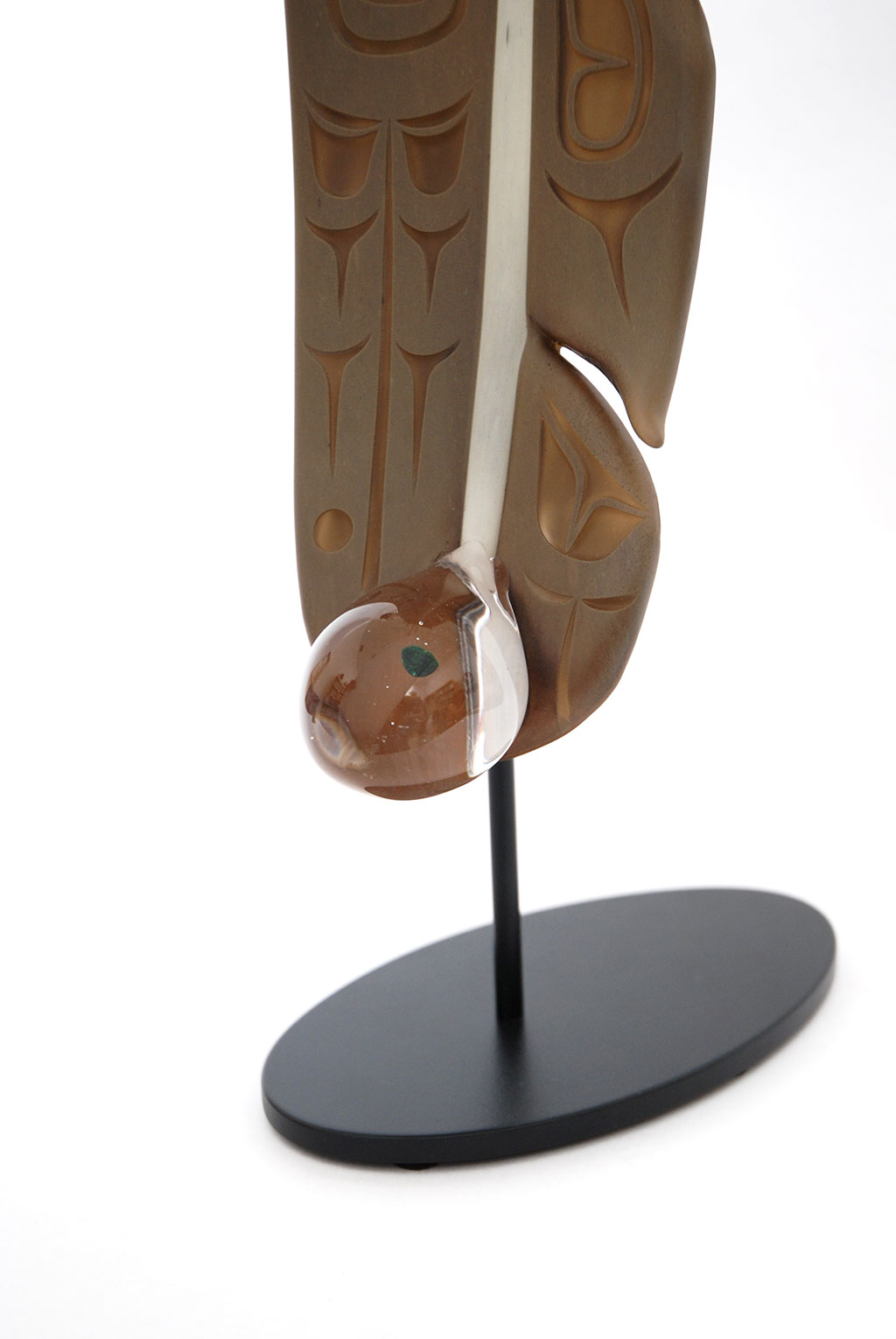
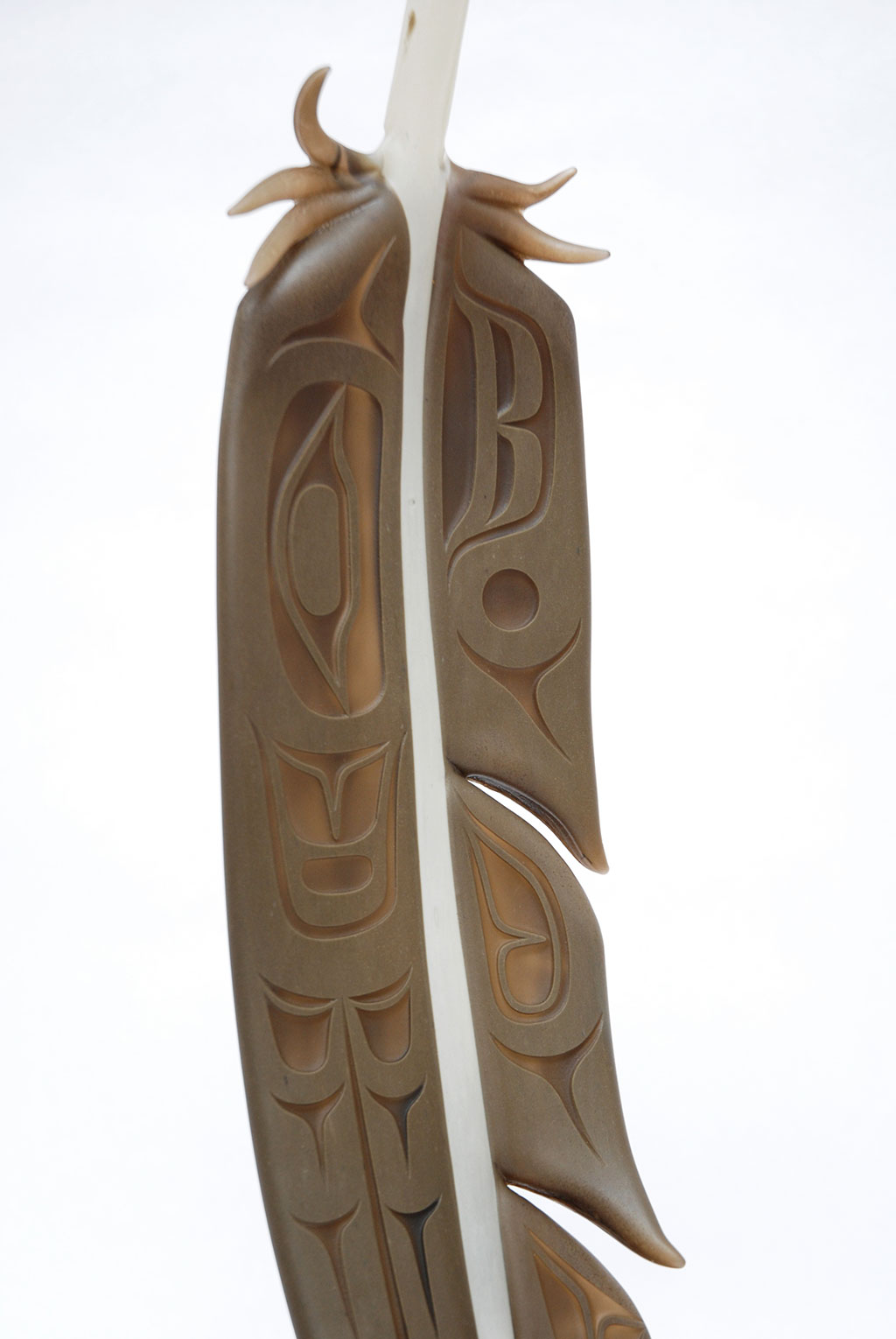
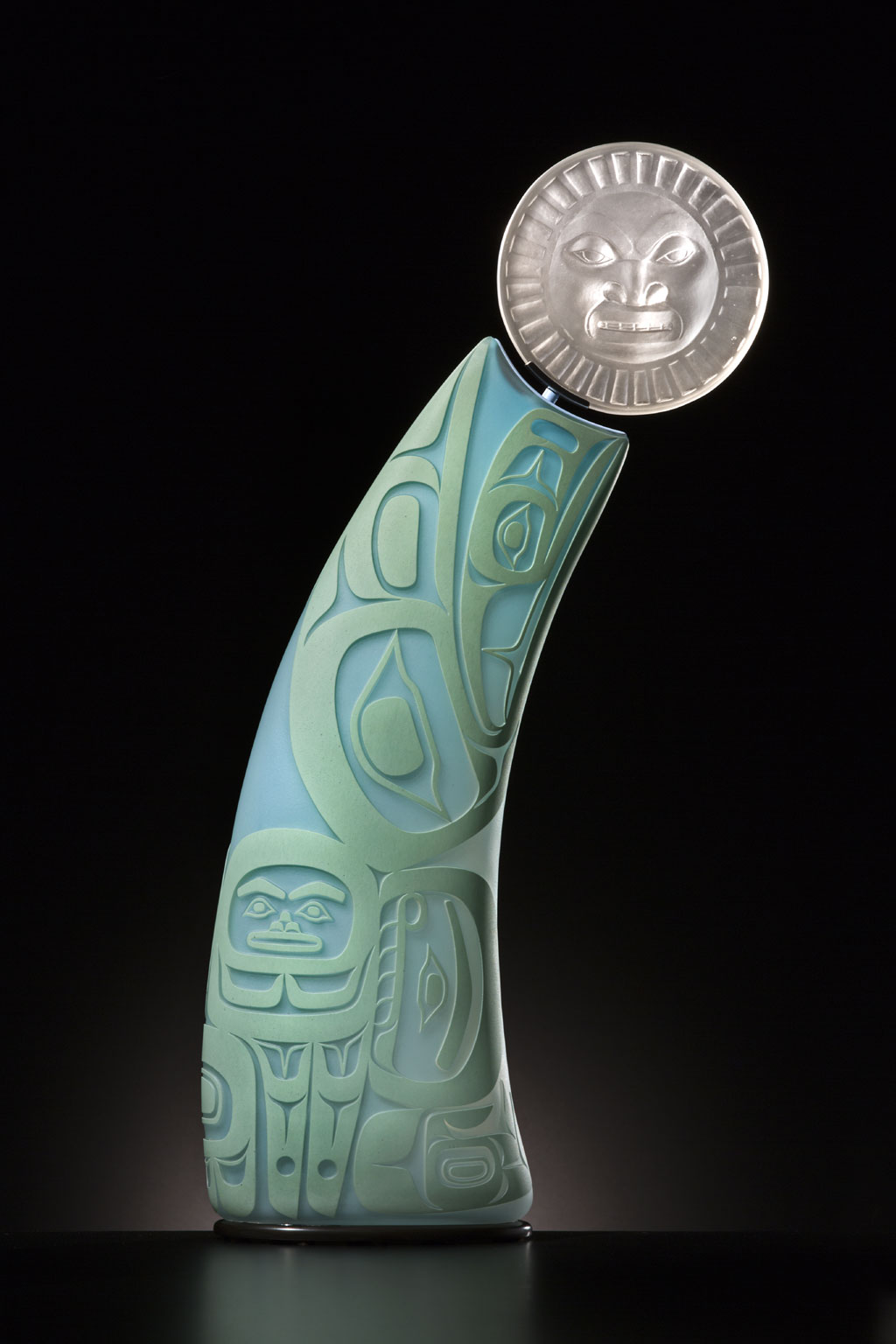
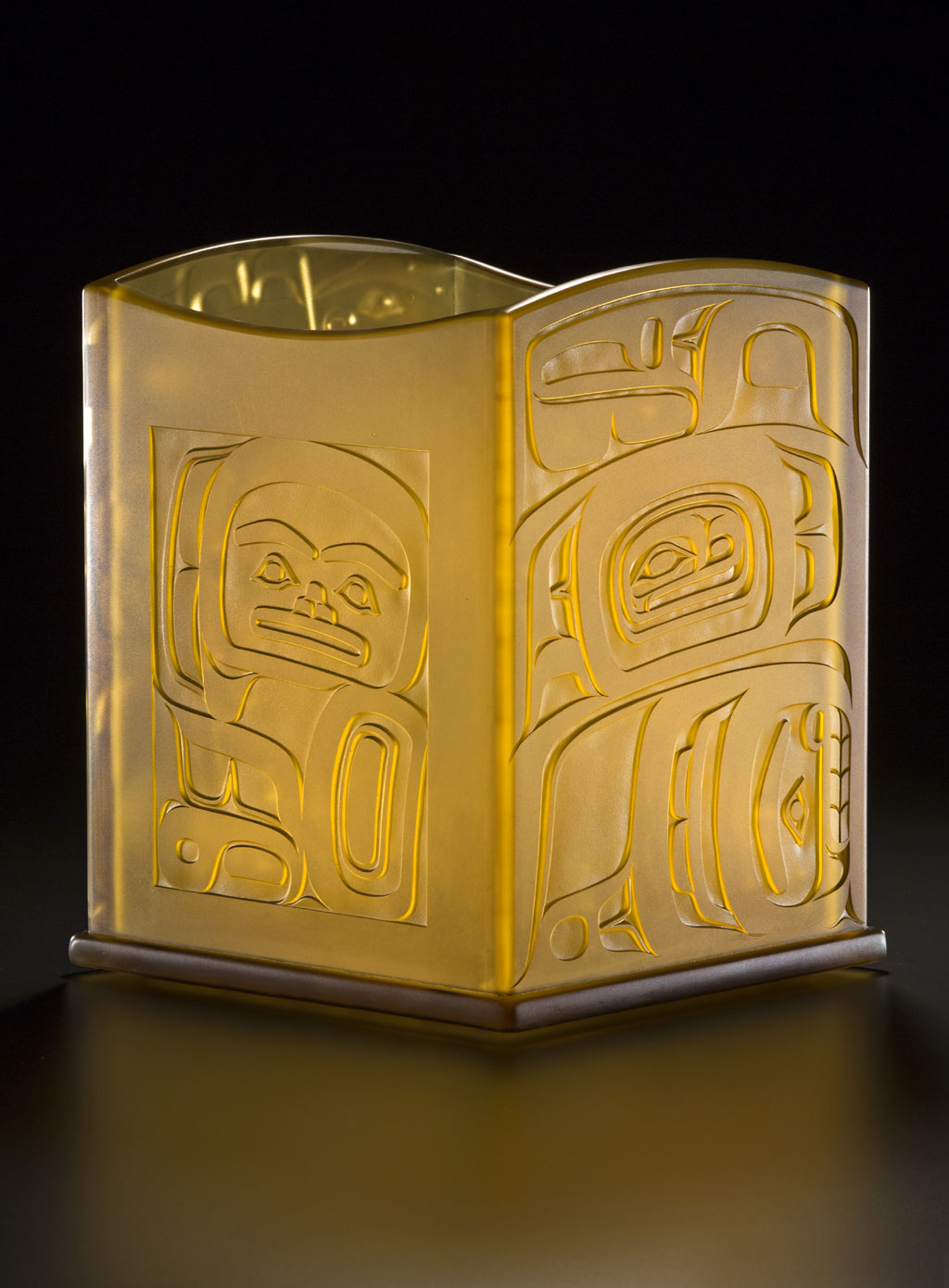


After Viewing
Begin a discussion of the video. What did students find interesting? What questions do they have? Using students’ notes, discuss the information they gathered about the listed categories. Following are discussion ideas and potential answers to the questions above.
Discussion
- How does Singletary describe his position as an artist? Singletary considers himself a bridge joining traditional Tlingit culture with new ways of sharing the stories and knowledge.
- Why does he work in glass? The artist notes that many traditional northwest materials are gone or in short supply. Introducing glass provides a new, plentiful material but also a new way of creating traditional art.
- What is a curator? After entertaining guesses, have students look up this word in several sources. Curators may be responsible for planning art shows, acquiring art for institutions, deciding what to exhibit, and caring for artworks.
- What does storytelling provide for the Tlingit people? Miranda Belarde-Lewis states that “Native storytellers are the best storytellers in the world because our stories carried knowledge…that was needed to survive…” Also, environmental knowledge was passed along through storytelling.
- What is “bounded space?” Miranda Belarde-Lewis shares this definition from Apache philosopher Viola Cordova: “In Native American philosophy, bounded space is the natural environment one exists in; and the relationships one has with that space. Cordova believed this space affects everything about a person: their language, culture, spirituality, and their aesthetics (how they believe something should look, or their ideas of beauty.) What do students think of this philosophy?
- Is each piece of the show an artwork on its own? What does studio assistant Joseph BenVenuto say about the pieces? BenVenuto remarks that “One piece of his (Singletary’s) work is merely one line in a story.” This is a different view of art objects than the western view of each crafted object being precious in itself. This topic could be interesting to discuss with students. Have they ever crafted a piece that was part of a whole, and not complete in itself?
- How important is environment to the artist and the curator? To the Tlingit people? Preston Singletary and Miranda Belarde-Lewis each comment on sustainability. For example, the preservation of natural species such as the cedar trees, used for canoes, baskets, and more was (and perhaps remains) essential to survival.
- What are the jobs of Singletary’s studio production team? Encourage students to describe how they see studio glassworking assistants Sean Albert and Joseph BenVenuto, master cutter Brittaney Shanta, and sandblaster Terri Rau working.
- What is the story of Raven and The Box of Daylight? Have students tell the story. Ask them to look up versions of the story online. Does the story remind students of other stories they have heard? Discuss the term origin story and ask students to name other examples of origin stories.
After Discussion: Investigation
Worksheet: The Ecology of Art Materials
Have students research and share information in small groups. Then have the class share as a whole. Have each student responsible for creating one information card (such as a large index card) about one material that can be posted on a bulletin board for the education of all.
Worksheet: Crafting a Tale of Ecology
This worksheet introduces the story and diorama project
Studio Production (four 45 minute class periods)
The salmon is going to play a part sort of like stagecraft. I’ll have glass on the ground that looks like the river and these salmon are going to be kind of floating above the top.
– Preston Singletary
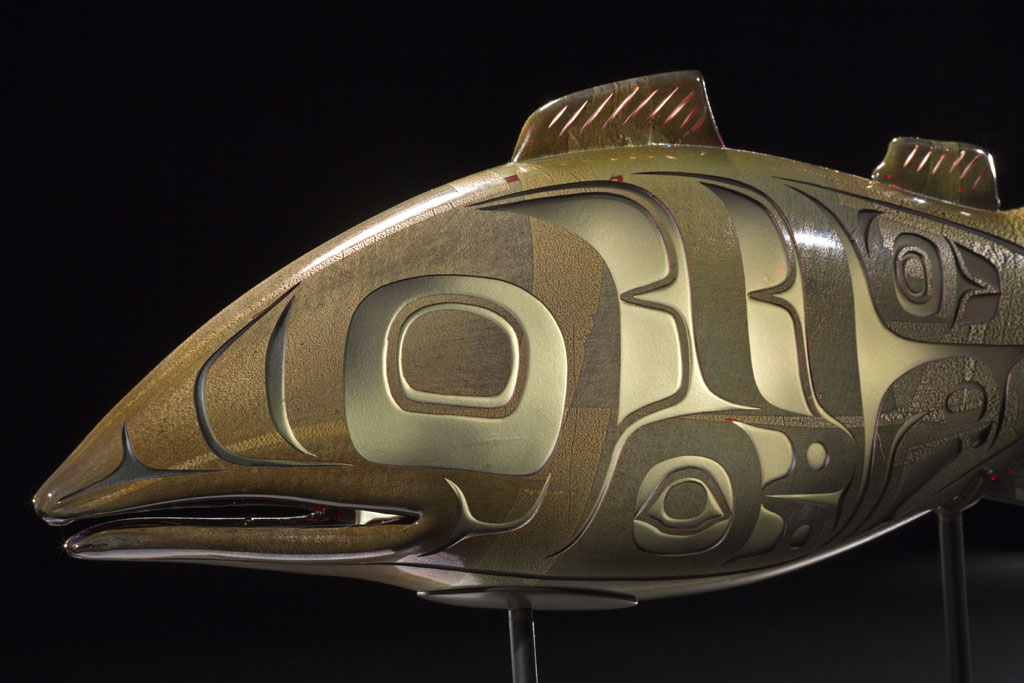
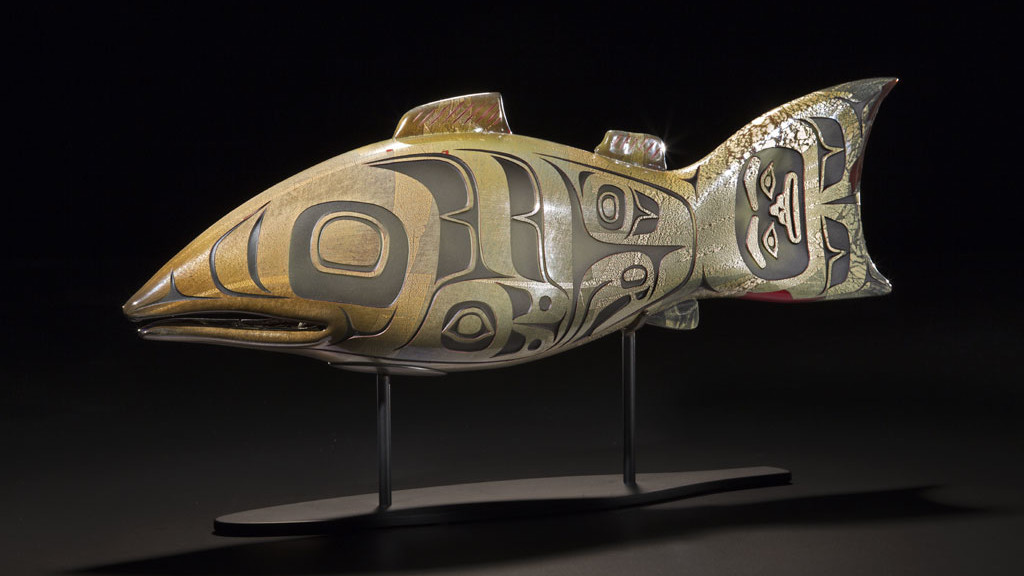
After using the worksheets, students should have ideas for stories they intend to rewrite and dioramas they can create. Story ideas could start with fairy tales, such as retelling Goldilocks and the Three Bears as Goldilocks wreaks havoc in the bear’s environment. Students may have stories that already include an environmental component, such as from blockbuster disaster films or from comics. Have students write the story in their sketchbooks and embellish the tale with sketched ideas for their dioramas.
The diorama projects can vary according to students’ ideas. Some students may have traditional crafts practiced in their family that can become part of the scene and add more meaning; for example a knitted landscape. Students who camp, fish, hunt, or practice outdoor sports might want to include references to those family traditions in their story and their diorama.
To make a diorama, begin with a box set on its side to form a small “stage.” Prime the box by covering it with paint, paper, or fabric inside and out. Set the scene: Like stagecraft, add a background, and flooring base. Position characters and props by gluing found or crafted pieces in place. Consider the outside of the box as well as offering several surfaces for further treatment and visual embellishing of the story.
Reflection
It will also be enhanced by video, projecting onto glass and creating sort of a backdrop. I wanted to create this atmosphere of the northwest coast, with this mist rising out of the trees. It would transform the viewer into another place.
– Preston Singletary
Encourage students to work with each other to curate a show of what they have produced. They can decide on whether the exhibit should be brief or extended, where it should be placed, how it should be arranged. Do they think there should be video or recordings to accompany the show? Singletary talks about stagecraft and theatrics as a way of telling stories. He mentions having the story told in the Tlingit language playing in the background of his show, adding a layer of ambiguity for those who do not speak the language, yet adding to the “authentic” experience of the northwest. Students may want to consider these ideas in their own show planning.
Assessment
In discussions with the class and with individual students throughout the lesson; by examining the students’ worksheets; and by witnessing the students’ studio work, it should be evident that the student:
- Understands that connection to environment and place can be a theme for an artist’s work.
- Researched the sustainability and ecological significance of their chosen art materials.
- Rewrote a traditional tale including an ecological metaphor and presented the story in a diorama.
Extensions
Glasswork: Setting up a lampworking studio in the classroom is not inexpensive but a possible option with fundraising. Lampworking allows students an experience sculpting small projects (such as beads) with molten glass.
Authors
The Education Guide for NATURE was developed under the direction of Dr. Marilyn Stewart, Professor of Art Education, Kutztown University of Pennsylvania, Kutztown, PA. Lead author for Crafting a Tale of Ecology is Dr. Amy Albert Bloom, April 2017